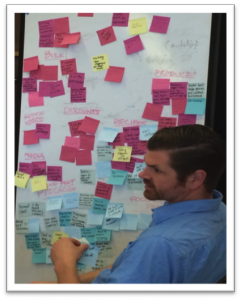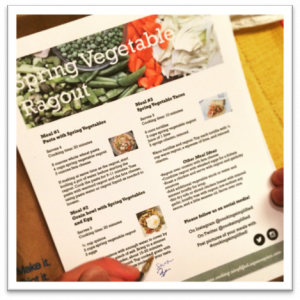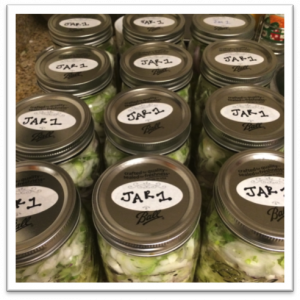Blog post by project team Cooking Simplified, with team members Michelle Azurin, Ben Maring, and Sara Draper-Zivetz.
“How might we make home cooking the delicious, affordable, and convenient choice?”
Our team of three didn’t really know what we were in for when we agreed to work together to answer this question as students in “Eat. Think. Design.”
The members of our team come from diverse backgrounds; we’re a city planning student with  dreams of social entrepreneurship, a physician with cooking skills that would make even Mario Batali blush, and a public health nutrition student who secretly loves Taco Bell. We brought together unique experiences, passions, and goals—and took away much more than just the “design-thinking” skills taught to us in the course.
dreams of social entrepreneurship, a physician with cooking skills that would make even Mario Batali blush, and a public health nutrition student who secretly loves Taco Bell. We brought together unique experiences, passions, and goals—and took away much more than just the “design-thinking” skills taught to us in the course.
We learned many valuable things in the past semester—from using sticky-notes to brainstorm ideas for programs that could encourage people to spend more time in the kitchen, to rapid ethnography to discover people’s shopping and cooking habits. We developed a unique skill-set that allows us to better understand how and why individuals make certain decisions and behave in certain ways by going straight to the source. Additionally, we learned about the importance of challenging each other and questioning ourselves often—much of which happened during the preparation for our pilot of Cooking Simplified, a service we developed as a potential solution to our “how might we…?” question.
Cooking Simplified aims to ease the process of cooking for many individuals who would otherwise opt for the convenience of a box of macaroni and cheese. Instead, we provide a box of pre-chopped and portioned produce and other whole ingredients to create batch meals. Cooking Simplified’s recipes and process is designed to minimize the time required for some of the most challenging elements of the cooking process. Most importantly, we prioritize affordability above all else because cost is a major barrier to eating healthfully for many people.
 Early on in our process, we were eager to test our idea and see if it could achieve its goals. We developed and tested out some prototypes, and modified Cooking Simplified based on the feedback we received. In April, after three months of researching, learning, testing and iterating, we launched a small pilot with the funds we were provided through the course. Serving 12 customers in the Bay Area, we learned about the challenges of running a business and provide a service designed to meet the wants and needs of a diverse population.
Early on in our process, we were eager to test our idea and see if it could achieve its goals. We developed and tested out some prototypes, and modified Cooking Simplified based on the feedback we received. In April, after three months of researching, learning, testing and iterating, we launched a small pilot with the funds we were provided through the course. Serving 12 customers in the Bay Area, we learned about the challenges of running a business and provide a service designed to meet the wants and needs of a diverse population.
One of the most difficult parts of the pilot project was learning, from a business perspective, how to create a service that is financially sustainable. With limited funding, we had to translate our values into dollars and truly understand which aspects of the service we felt should be prioritized (so that Cooking Simplified was still affordable for the average person).
We began to question our values and the values of our target population—do people really care about organic produce, especially if they are eating on a budget? Is canned produce just as good as fresh produce (and does this even matter)? Is one of our objectives to educate the public as well, or are we simply looking to ease the process of cooking for our customers?
care about organic produce, especially if they are eating on a budget? Is canned produce just as good as fresh produce (and does this even matter)? Is one of our objectives to educate the public as well, or are we simply looking to ease the process of cooking for our customers?
We learned that sometimes our priorities are not the same as those of our users. We still need to dig deeper to better identify and truly understand our target population(s). Our prototypes allowed us to see if others agreed that the solution we designed is a solution for them; by collaborating with potential customers during the design process, we were able to create something they may actually find valuable. We hope to incorporate the feedback we received from our pilot into future iterations of the service—although the course may be over, our utilization of design thinking is not!
Through this entire process, we have become aware of the realities of what it means to be an eater in America from a food systems perspective (an overarching theme of the course). The project allowed us to better understand everything from where our food is sourced to how it ends up on our plates—and how Cooking Simplified can make everything in between more economical for people so that homemade meals, rather than fast food or microwave dinners, becomes their default choice.

